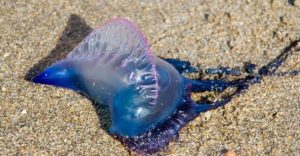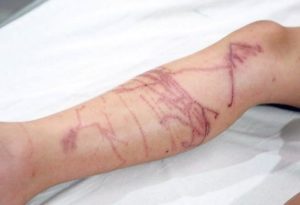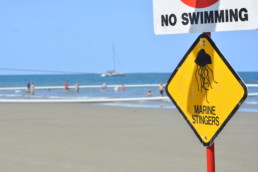Jellyfish Season in Oman
Swimmers, divers and casual beach goers are advised to watch out for jellyfish when they venture into the sea.
As the temperature rises and the water along Oman’s coastline gets warmer, Jellyfish numbers increase. See the prolonged onshore winds drive the jellyfish shore wards. Some sting but many don't.
These passed few year though, there has been sightings of the more dangerous verity. They are rare, but do occur here in Oman primarily between the months of March to June, and people have been stung on a few occasions. These jellyfish could cause more serious public health problems and are worth keeping an eye out for.

Crambionella Orsini
A reddish white jellyfish known by locals as Doll Jellyfish are especially abundant. Especially seen in the Daymaniyat islands and Al Fahal Islands. Luckily they are non toxic. Though not harmful, an exposure to these jellyfish can lead to skin irritation and redness.
Box Jellyfish
This venomous jellyfish looks like a plastic bag with four two-meter long tentacles that are extremely stinging. It is at its most dangerous when it is hunting, as they can stretch their tentacles for a wider reach. They are painful and may cause low blood pressure or difficulty in breathing.
Bluebottle Jellyfish (Man O’ War)
These highly venomous jellyfish have been found in the waters between Al Mughassil Beach in Salalah and Taqah Beach. They float on the surface with a bubble of air in them, and their tentacles can be tens of meters long. As a swimmer, you get entangled in the tentacles before you actually see the animal because they can be five or six meters away, and due to their colour it's practically transparent in water. These beautiful but deadly jellyfish have been known to cause deaths, so seek immediate medical care.
Symptoms
 Common signs and symptoms of jellyfish stings include:
Common signs and symptoms of jellyfish stings include:
- Burning, prickling, stinging pain
- Red, brown or purplish tracks on the skin — a "print" of the tentacles' contact with your skin
- Itching
- Swelling
- Throbbing pain that radiates up a leg or an arm
Severe jellyfish stings can affect multiple body systems. These reactions may appear rapidly or several hours after the stings. Signs and symptoms of severe jellyfish stings include:
- Stomach pain, nausea and vomiting
- Headache
- Muscle pain or spasms
- Weakness, drowsiness, fainting and confusion
- Difficulty breathing
- Heart problems
Getting someone out of the water quickly that has been stung by one is very important. People can suffer shock and fear and are not able to get out on their own.
How to treat a jellyfish sting:
- Remove the victim from the water. If the species is identified as a particularly dangerous one, like the ones mentioned above, alert the emergency services.
- Wash with vinegar to neutralise the stinging cells. Do NOT rinse with fresh water or urine and avoid rubbing the affected area as this will trigger the stinging cells to release their venom and intensify the pain.
- Keep the victim still and avoid elevating the affected area to avoid toxins spreading through the body.
- Remove any visible tentacles using sterile tweezers, forceps or gloves and rinse area thoroughly with salt water to wash away any remaining nematocysts (stinging cells).
- Immerse the affected area in hot water or apply a heat pack (approximately 45°C) to reduce the pain. Some physicians may also recommend painkillers, anti-inflammatory or topical anesthetic may also be used.
Call these numbers in case of emergency while in Oman
Emergency call to Royal Oman Police – 9999
Ambulance services – 9999

